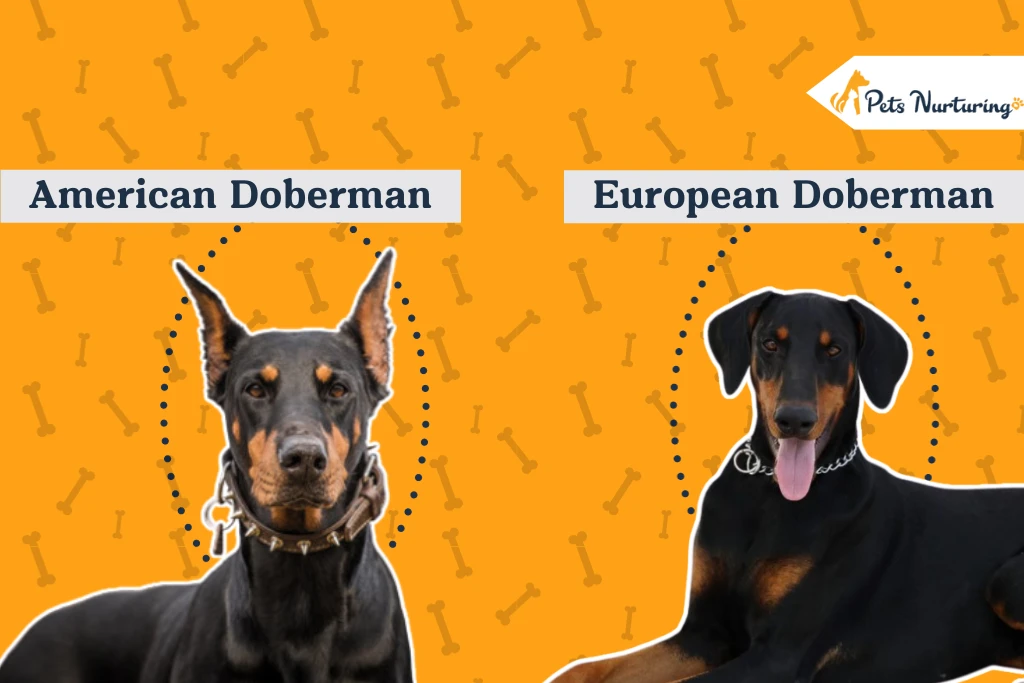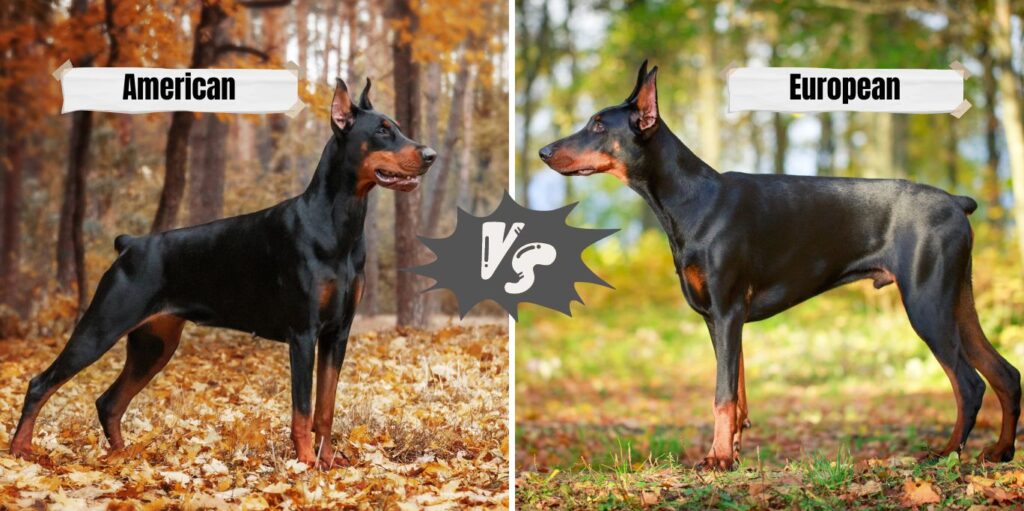
American Vs. European Doberman, Is there a difference? You may wonder! Well, to everybody’s surprise, yes, there are differences between these two breeds far beyond visual capacity. It might be difficult for an outsider to differentiate between these two wonderful canine breeds standing right in front, but there are physical, behavioral, and ancestry disparities between the American Doberman and European Doberman.
The primary difference is in the nomenclature itself. The American breed is referred to as “Doberman Pinscher”, while the European breed is simply referred to as “Doberman”.
The differences go much beyond just the names, and if you are a dog-lover, just like us, you will love exploring the beautiful worlds of these Dobermans. Whether they are working dogs or family dogs, you’ll get to know everything about them.
Let’s learn about American Dobermans and European Dobermans. Keep reading…
American Doberman possesses a sleek and refined appearance, making him a perfect show dog. Pinscher possesses a temperament that aligns with family life. On the flip side, European Dobermans possess a completely different persona. They are big, muscular , built for demanding roles and tasks. European Dobermans are often considered working dogs as their temperament suits the professional environment.
American and European Doberman overview:
| American Doberman | European Doberman | |
|---|---|---|
| Height | 24-28 inches | 25-29 inches |
| Weight | 60 to 100 pounds | 65 to 105 pounds |
| Lifespan | On average 10 to 12 years | On average 10 to 12 years |
| Colors | Black, red, blue and fawn | Black or red |
| Markings | Rust-colored markings on the chest | Dark rust-colored markings on the chest |
| Build | Long, thin, refined athletic-like build, perfect show dog | Compact, thick, and muscular body. |
| Head | Thinner head aligning with muzzle and jaw | Broader head aligning with thick muzzle and jaw structure. |
| Eyes | Light brown | Dark brown |
| Neck | Long and thin neck | Short and thick neck |
| Chest | Small and narrow chest | Large and broad chest |
These two breeds look very similar, however, you can see a significant difference as you observe the picture given below.
Difference Between American Doberman and European Doberman

Physical Differences:
One of the subtle differences between these two breeds lies in their physical characteristics.
The European Doberman typically weighs somewhere between 65 to 105 pounds, while the American Doberman weighs between 60 to 100 pounds, slightly less than their counterparts. This fine difference in their weights may only become visible if you inspect them closely.
In terms of heights, The European Doberman is taller, ranging from approximately 25-29 at the shoulders, while the American Doberman is a bit compact, with heights ranging from 24-28 inches.
The height standards for the American Doberman are defined by the American Kennel Club, AKC standard, and for the European Doberman is defined by the Federation Cynologique Internationale, FCI standard. It is less likely to notice these differences in appearance right away.
Further, the physical differences between the two breeds are not limited to height and weight, but they extend to various attributes that can be observed only if you observe them closely.
American pinschers have a distinct set of physical features and are characterized by narrow heads, sharp neck rise, toned bodies, compact feet, leaner muscle mass, and smaller chests, which gives them an elegant look. This sleek-looking dog has a body similar to that of an athlete. American Pinschers have long & thin legs with smaller paws, and overall, the body is quite longer and thinner. These graceful-looking attributes of the American Doberman make the dog a family favorite.
In contrast, the physical appearance of European Dobermans is more sturdy than that of Americans. European Dobermans have a broader head, slow neck rise, larger chest, and more substantial muscle mass. The thicker bone structure makes them suitable for rigorous working roles. One noticeable thing about the European Dobermans is their practice of cropped ears. This tradition easily distinguishes European dogs, and one can identify the European Doberman by just looking at its ears.
Ancestry and Purpose:
Both the Dobermans share a common origin in Germany during the 1980s. However, the breeding evolved in distinct geographic regions,with the American Doberman only bred in America and the European Doberman only bred in Europe. This led to unique breeding characteristics and purposes. Today, both have different breed standards , and one must adhere to them to raise a purebred. To raise an exclusive American breed Doberman, one must adhere to the standards laid by the American Kennel Club. Similarly, to raise an American breed, one must adhere to Federation Cynologique Internationale standards.
Behavior
In 2021, an extensive survey conducted by the Doberman Planet collected valuable insights from over 82 real-world owners of both the Doberman breeds. The analysis of this survey suggested noticeable differences in the behavior and training preferences of these two breeds.
Assertiveness
In the behavior of Assertiveness, European Dobermans are more assertive and direct, especially when they demand attention. European Dobermans are famous for their confident and demanding approach. While the American breed is more reserved and less assertive during interactions. Their behavior is often characterized by shyness and a gentle way of seeking attention.
Second, one of the key differences in the behavior lies in their preferred training style. Both breeds prefer different training styles; one prefers positive reinforcement, while the other prefers firm direction only. Yes, the American breed prefers a positive and softer approach to responding to the training. They thrive on encouragement, reward, and a softer approach. The American breed is eager to please while responding to the training. While the European breed prefers clear and firm direction training. They respond quickly to assertive guidance and are trained to follow firm commands.
Age at Mental maturity
This information about Doberman’s mental maturity sounds quite interesting. Statistical data reveal that 61.8% of American Dobermans reach mental maturity by the age of 2. In contrast, 58.3% of European Dobermans reach mental maturity by the age of 2. The difference in the age at which these breeds attain mental maturity suggests variation in the cognitive and emotional development of these two breeds. The results show that American Doberman Pinschers become mentally mature earlier than European Dobermans.
LifeSpan
Both of these Doberman breeds do not have any major differences in their lifespans. On average, both these loyal canines live for around 10 to 12 years. However, the actual lifespan may vary depending on various factors such as breeding, genetics, and overall health during the lifespan.
Energy Levels
You might wonder, how do the energy levels of the breeds make a difference? Well, the energy levels impact the daily activities you will need to perform these fur babies. On a scale of 10, the American breed is at a score of 6.2 in energy levels, and the European breed is at a score of 7.7. This implies that the European breed is more active and will keep you on your toes throughout the day. They will require more physical and mental stimulation to be active.
Acceptance of Strangers and behavior with the family:
To our pleasant surprise, both these breeds offer similar levels of acceptance when encountering strangers. However, as their personality trait is different, the European breed often comes out as a more confident dog than the American breed. This means the European breed appears self-assured while talking to strangers. They come across as more composed and assured in any new situation.
On the other hand, American Dobermans are more protective and want to enjoy the comfort of their pet parents. They share a close bond with their family members and love their presence around them. Pinschers tune in closely with the emotions of the pet parent and quickly adapt to its needs.
Both these breeds share a deep and loyal bond with their respective families. They are capable of forming strong connections, which makes them the most suitable dogs for families.
Coat Quality and Color:

The color difference between the breeds is extremely difficult to visualize. Only a trained eye can spot the subtle difference in colors of Doberman and the markings between the two.
As described by the AKC, the American Doberman has a smooth, soft, close-lying, and thick coat. A few dogs of the American breed also have an invisible gray coat under the neck. While the colors are challenging to differentiate, rust-colored markings of Doberman are considered an ideal one in the American breed. These markings are typically seen above:
- Each eye
- On the pup’s muzzle, throat, and forechest
- On the legs, feet
- Below the tail
Also some of the Dobermans also have white patches on their chest. According to the AKC standards, these patches should not exceed half a square inch to match the American Doberman breed.
These rust-colored markings are not common in European dogs, which makes a significant difference between the two.
Now-coming to European Dobermans possess a short, dense, and hard coat. FCI acknowledges two shades of European breeds, black and brown with rust (limited markings). The European Doberman parents must produce only these two shades to be able to fit the FCI standards. Interestingly, some parents stand out by adopting blue, red, and fawn European dobies.
Talking about markings, the FCI accepts only tan-color markings. These markings are usually found on
- The muzzle
- Above the eyebrows
- Under the tail
- On the throat
- On the forechest
- On the hind thigh’s inner side
- Under the tail
- On the forearms
Compiling the above points of comparison, let’s revise the differences between the two classic Doberman breeds.
| American Doberman | European Doberman | |
|---|---|---|
| Temperament | Caring, affectionate, loyal, ideal for family dog | Loving, confident, ideal for working dog |
| Behavior with family | Very caring, loving, and protective. Enjoys human company and is always in tune with human emotions | A very loyal and confident dog. Remains in tune with pet parent’s emotion |
| Training style | Prefers gentle and personal approach while training. Responds quickly to polite assertiveness. | Prefers a direct training approach. Very highly active and keeps the parents on their toes |
| Behavior with strangers and in unknown environment | Becomes uncomfortable in a new environment and needs pet parents’ reassurance. | Quite confident even when exposed to new surroundings. |
| Family dog/Work Dog | Best serves as a family dog | It best serves as a working dog. |
| Couch potato/Active dog? | Often becomes a couch potato | Definitely not a couch potato, but a space Dog. |
Health Issue Differences:
American Dobermans and European Dobermans both these breeds are prone to the same list of health issues, including:
- Gastric dilatation
- Volvulus syndrome
- Hip Dysplasia
- Dilated cardiomyopathy
- Chronic active hepatitis
- Von Willebrand’s disease
- Cervical vertebral instability
- Progressive retinal atrophy
- Hypothyroidism
- Osteosarcoma
Both breeds are susceptible to specific health concerns. One of the common health issues faced by both breeds is Dilated Cardiomyopathy. This disease involves enlargement of the heart, leading to a reduction in heart function.
American Pinschers are likely to develop this common issue called Dilated cardiomyopathy. Unfortunately, the health testing of these puppies is a costly affair.
In the case of European Dobermans, 58% of Dobermans also face the same health issue of DCM in their lifespan, quite higher than the Pinschers.
The difference in puppy prices:
The average price of an American Doberman Pinscher is between the range of $1,500 and $2,500 in the United States. The average price of a European Doberman puppy is between $25,00 and $3,500 (if purchased in the United States).
And, if you are based in European countries, you can purchase these European puppies in the range of $500 to $2,000.
Also, the puppy price varies drastically based on the following other factors:
- Reputation of the breeder
- Genetic testing
- Vaccination cost
- Ear cropping
Now, the approach to breeding varies significantly between the United States and Europe; America is quite liberal as compared to Europe. Anybody is free to breed Dobermans in America without facing any legal restrictions. However, the same is not the case with Europe. You are not legally permitted to breed Dobermans without passing ZTP testing.
The rigorous ZTP testing focuses on self-assurance, stability, nervous disposition, natural drives, and protective instincts of the dogs.
Dogs are analyzed for their behavior in chaotic environments, and if they fail the test, breeding of the dog is not allowed.
Choosing the right Doberman:
The selection of a Doberman will depend majorly on the environment in which you plan to bring the dogs to life. We have listed various behaviors and characteristics of both breeds, and it is upon you to select the one that fits your family’s priorities.
If you are planning to become a new pet parent, opt for American Pinscher, as this dog reads human emotions well. If you are an experienced pet owner, go for a European Doberman. Whichever breed you choose, you are going to have the experience of a lifetime. It’s time to make pleasant memories with your fur baby.
Explore Further:











